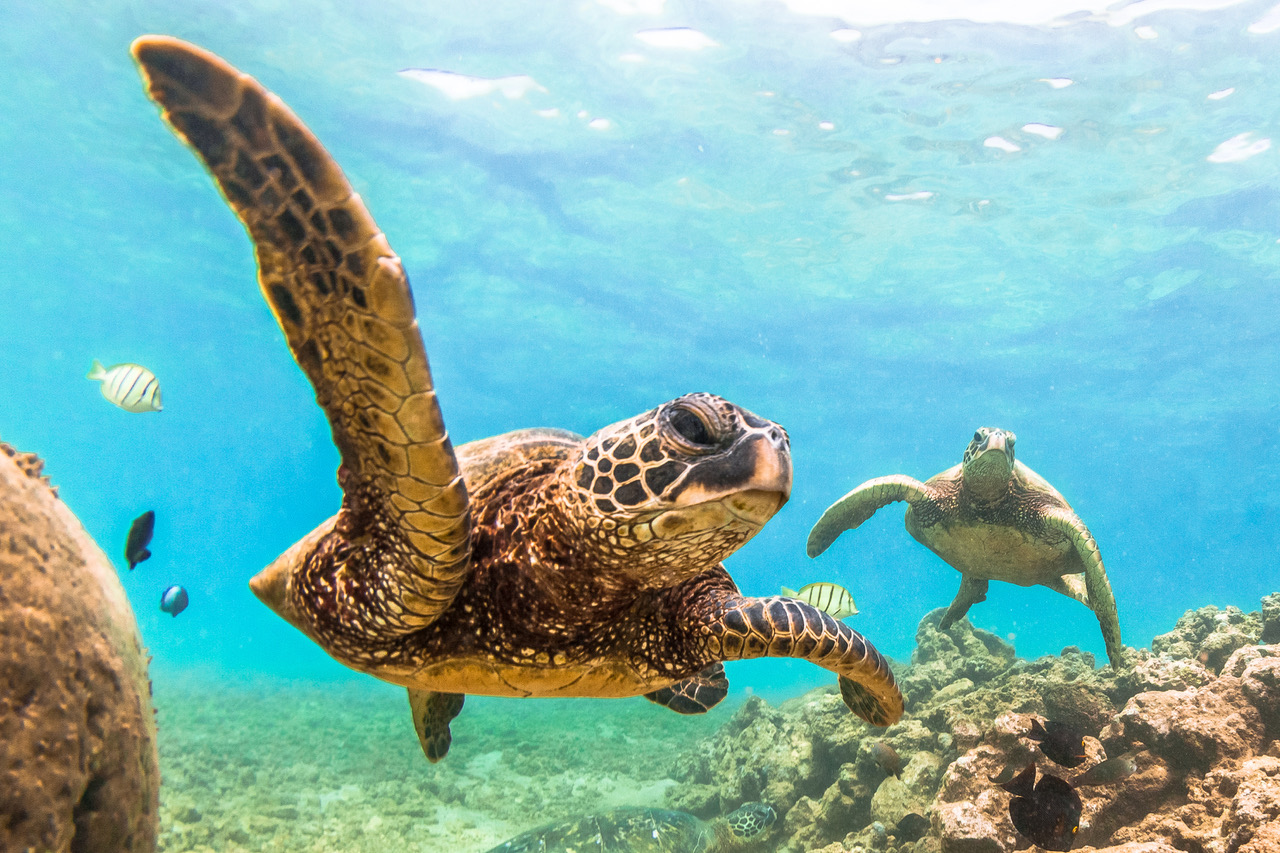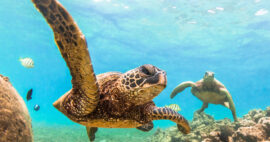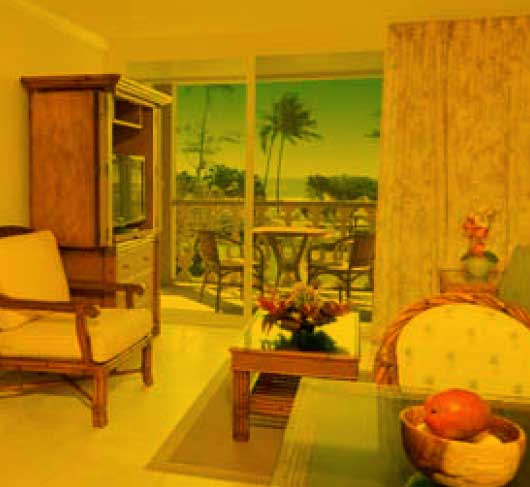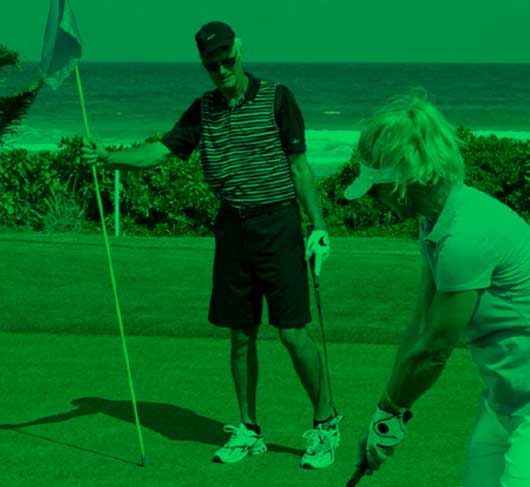Top Wildlife Viewing on the Royal Coconut Coast
Kauai visitors can see several types of wildlife from different vantage points on Kauai’s Royal Coconut Coast, AKA Kauai’s East Side. Most are considered endangered or threatened species. Taking pictures is no problem. Getting too close is. Approaching an endangered animal threatens them and can alter its behavior. The standard rule is to stay at least 10 feet away whether they’re resting on the beach or swimming.
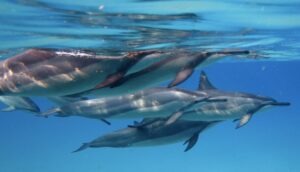 Dolphin: Spinner Dolphin most often swim in pods and are primarily seen while boating, paddling, kayaking or scuba diving in the ocean. Those who are taking a boat tour will often see dolphin following, leading or playing around the vessel, providing a delightful show. Spinner dolphins, like all marine mammals are protected under the Marine Mammal Protection Act (MMPA). NOAA Fisheries is dedicated to conserving spinner dolphin populations through numerous management and regulatory actions. Source and photo NOAA.
Dolphin: Spinner Dolphin most often swim in pods and are primarily seen while boating, paddling, kayaking or scuba diving in the ocean. Those who are taking a boat tour will often see dolphin following, leading or playing around the vessel, providing a delightful show. Spinner dolphins, like all marine mammals are protected under the Marine Mammal Protection Act (MMPA). NOAA Fisheries is dedicated to conserving spinner dolphin populations through numerous management and regulatory actions. Source and photo NOAA.
Giant Green Sea Turtles: The giant green sea turtle is the largest known hard-shelled sea turtle. Unique among sea turtles in that they are herbivores, they eat mostly seagrass and algae. This diet gives their fat a greenish color (not their shells), which is where their name comes from. This amazing animal often swims near our shorelines and are viewable from bluff locations like Kapaa Lookout, located just north of Kapaa town on the right and from several beaches. Green sea turtles can be seen in the water when they come up for air. On land they bask in the sun on beaches. Turtles nest their eggs on beaches from September to December. Stay at least 10 feet away from a beached green sea turtle. While snorkeling or diving, the same rules apply. Source and photo, NOAA Fisheries
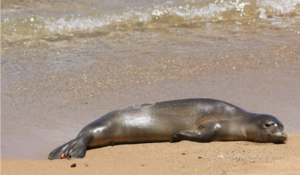 Hawaiian Monk Seal: The Hawaiian monk seal is one of the most endangered seal species in the world and endemic to the Hawaiian islands, occurring nowhere else. These seals are protected under the Endangered Species Act, the Marine Mammal Protection Act, and Hawaii State law. Seals haul out onto our beaches to sleep after a night of foraging for food in our waters. Mother’s with pups also hang out on beaches during a period that the mother teaches the pup about swimming and foraging. Keep your distance, walk as far around them as you can. Do not approach. Use your zoom if you want a great photo. Source and photo, NOAA Fisheries
Hawaiian Monk Seal: The Hawaiian monk seal is one of the most endangered seal species in the world and endemic to the Hawaiian islands, occurring nowhere else. These seals are protected under the Endangered Species Act, the Marine Mammal Protection Act, and Hawaii State law. Seals haul out onto our beaches to sleep after a night of foraging for food in our waters. Mother’s with pups also hang out on beaches during a period that the mother teaches the pup about swimming and foraging. Keep your distance, walk as far around them as you can. Do not approach. Use your zoom if you want a great photo. Source and photo, NOAA Fisheries
Humpback Whales: From November through March, Humpback Whales show up around Kauai, after migrating from the Gulf of Alaska. While in Hawaiian waters, they mate, give birth to their pups and raise their young. These creatures often give spectacular shows off our shorelines breaching out of the water, and splashing back down. From the shoreline, whale watching is most popular at the Kapaa Look-out, just north of Kapaa Town on the right side. Local boat tour companies like Blue Dolphin Charters or Holo Holo Boat Tours, offer a selection of whale-watching tours.
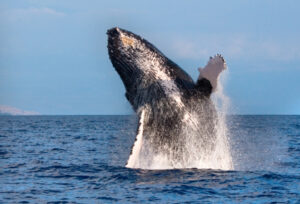
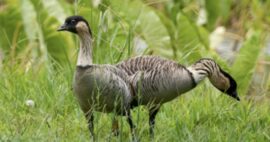 Nene Geese (pronounced nay nay): This proud goose is Hawaii’s state bird and is endemic to Hawaii. It has a black head and bill, buff cheeks, a buff neck with dark furrows, and partially webbed black feet. The reduction of webbing between their toes and upright posture allows walking more easily particularly on lava. Its calls are similar to Canadian geese but they also give a low tone “nay” or “nay-nay” call. Once practically extinct in the 1940s the population has recovered well since then through federal, state and non-government organization management. These geese are found on Kauai, Maui and the Big Island. Nene frequent scrubland, grassland, golf courses, sparsely vegetated slopes and, on Kauai, open lowland country too. Wailua Golf Course is a frequent place to see Nene, lowland parks and the Keahua Arboretum are also good spots to encounter Nene. They are especially vulnerable to predators during nesting season from August through April. Source and photo: Pacific Islands Fish and Wildlife
Nene Geese (pronounced nay nay): This proud goose is Hawaii’s state bird and is endemic to Hawaii. It has a black head and bill, buff cheeks, a buff neck with dark furrows, and partially webbed black feet. The reduction of webbing between their toes and upright posture allows walking more easily particularly on lava. Its calls are similar to Canadian geese but they also give a low tone “nay” or “nay-nay” call. Once practically extinct in the 1940s the population has recovered well since then through federal, state and non-government organization management. These geese are found on Kauai, Maui and the Big Island. Nene frequent scrubland, grassland, golf courses, sparsely vegetated slopes and, on Kauai, open lowland country too. Wailua Golf Course is a frequent place to see Nene, lowland parks and the Keahua Arboretum are also good spots to encounter Nene. They are especially vulnerable to predators during nesting season from August through April. Source and photo: Pacific Islands Fish and Wildlife
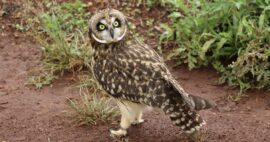 Pueo (Hawaiian short eared owl): Endemic to Hawaii and on the endangered species list, the Pueo is distinguished by its yellow eyes, round face and dark brown streaking on its feathers. It’s a smaller owl as compared to the more common and larger barn owl, an introduced species with lighter feathers. The Hawaiian culture has great reverence for the Pueo as it is one of the more famous of the various physical forms assumed by ʻaumākua (ancestor spirits). Pueo inhabit forests and grasslands and might be seen on one of the three Nounou Mountain trails, or Kuilau Ridge Trail. Photo, Hawaii Department of Land and Natural Resources
Pueo (Hawaiian short eared owl): Endemic to Hawaii and on the endangered species list, the Pueo is distinguished by its yellow eyes, round face and dark brown streaking on its feathers. It’s a smaller owl as compared to the more common and larger barn owl, an introduced species with lighter feathers. The Hawaiian culture has great reverence for the Pueo as it is one of the more famous of the various physical forms assumed by ʻaumākua (ancestor spirits). Pueo inhabit forests and grasslands and might be seen on one of the three Nounou Mountain trails, or Kuilau Ridge Trail. Photo, Hawaii Department of Land and Natural Resources

